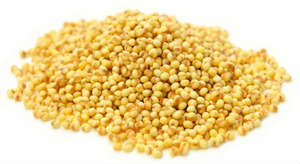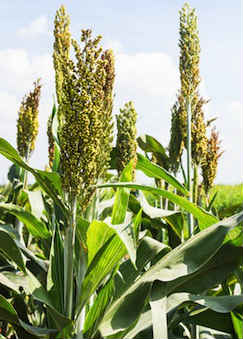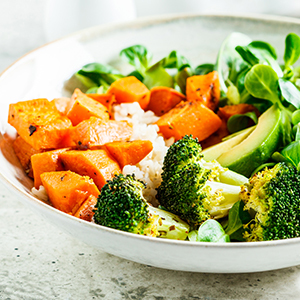
Sensitivity to gluten is on the rise, as is the demand for gluten-free foods; especially grains. Although there are many new, processed foods that are being marketed as gluten-free, a considerable number of people are taking a step back and looking to foods that humans have been relying on for ages – enter millet. [1] This tiny, gluten-free grain has been a staple in Asia and India for nearly 10,000 years. It's available in a variety of sizes and colors (white, yellow, gray, red). It may be roasted, cooked like rice, or prepared to a creamy texture similar to mashed potatoes. Whichever way you prefer it, millet is a healthy grain that offers many benefits. Here are the top seven reasons to add it to your diet.
Benefits of Millet
1. Excellent Nutritional Value
As with many ancient grains (like quinoa, spelt, and amaranth), millet ranks very high as a source of nutrients. It's loaded with folate and choline and provides important minerals like magnesium, potassium, phosphorus and zinc. Serving for serving, millet offers more dietary fiber and antioxidants than most other grains. [2] [3] [4]
2. Vegetarian Friendly Source of Protein
While the protein value of millet is similar to unprocessed wheat, millet is a richer source of essential amino acids. [5] In many areas of the world, millet is used as a weaning food for infants as it ensures continued availability of the protein required for growth and development. [6] One note – preparation does matter and roasting has been shown to retain the most protein. [7]
3. Low Impact on Blood Sugar
The more consistent your blood sugar levels are, the better. Research has confirmed the efficacy of millet, especially finger millet, in promoting healthy blood sugar. [8] [9] The hypoglycemic effect is owed to its ability at reducing starch digestion and absorption. [10]
4. Discourages the Development of Cataracts
Polyphenols in millet have antioxidants that inhibit the enzyme that triggers the development of cataracts. [11] Although it shouldn't be inferred that millet alone offers solid protection against cataracts, this research does suggest that a diet that includes millet may potentially stack the deck in your favor.

5. Defends Against Gallstones
A long-term study involving nearly 70,000 women aged 35-61 evaluated the impact of fiber on gallstone development. The women who reported the highest, consistent intake of insoluble dietary fiber, as present in millet, demonstrated less risk of developing gallstones. [12] Research like this shows that not only does millet have a lot to offer nutritionally, it also promotes good health and systemic function.
6. Supports Cardiovascular Health
A diet that includes a healthy amount of dietary fiber has shown a direct correlation with a healthy heart. Grains such as millet contain unavailable carbohydrates (fiber) and lignins known for their beneficial effects on vascular health. [13]The cultures that historically consumed grains like millet but have begun consuming processed grains such as white rice and flour have experienced a significant increase in diabetes and cardiovascular diseases. [14]
Add Millet to Your Diet!
References (15)
- Liu X, Jones MK, Zhao Z, Liu G, O'Connell TC. The earliest evidence of millet as a staple crop: New light on neolithic foodways in North China. Am J Phys Anthropol. 2012 Oct;149(2):283-90. doi: 10.1002/ajpa.22127. Epub 2012 Sep 8.
- Shobana S, Krishnaswamy K, Sudha V, Malleshi NG, Anjana RM, Palaniappan L, Mohan V. Finger millet (Ragi, Eleusine coracana L.): a review of its nutritional properties, processing, and plausible health benefits. Adv Food Nutr Res. 2013;69:1-39. doi: 10.1016/B978-0-12-410540-9.00001-6.
- Chandrasekara A, Shahidi F. Bioactivities and antiradical properties of millet grains and hulls. J Agric Food Chem. 2011 Sep 14;59(17):9563-71. doi: 10.1021/jf201849d. Epub 2011 Aug 15.
- Oghbaei M, Prakash J. Bioaccessible nutrients and bioactive components from fortified products prepared using finger millet (Eleusine coracana). J Sci Food Agric. 2012 Aug 30;92(11):2281-90. doi: 10.1002/jsfa.5622. Epub 2012 Mar 6.
- Kalinova J, Moudry J. Content and quality of protein in proso millet (Panicum miliaceum L.) varieties. Plant Foods Hum Nutr. 2006 Mar;61(1):45-9. Epub 2006 May 11.
- Geervani P, Vimala V, Pradeep KU, Devi MR. Effect of processing on protein digestibility, biological value and net protein utilization of millet and legume based infant mixes and biscuits. Plant Foods Hum Nutr. 1996 Apr;49(3):221-7.
- Malleshi NG, Hadimani NA, Chinnaswamy R, Klopfenstein CF. Physical and nutritional qualities of extruded weaning foods containing sorghum, pearl millet, or finger millet blended with mung beans and nonfat dried milk. Plant Foods Hum Nutr. 1996 Apr;49(3):181-9.
- Pathak P, Srivastava S, Grover S. Development of food products based on millets, legumes and fenugreek seeds and their suitability in the diabetic diet. Int J Food Sci Nutr. 2000 Sep;51(5):409-14.
- Chhavi A, Sarita S. Evaluation of composite millet breads for sensory and nutritional qualities and glycemic response. Malays J Nutr. 2012 Apr;18(1):89-101.
- Lakshmi Kumari P, Sumathi S. Effect of consumption of finger millet on hyperglycemia in non-insulin dependent diabetes mellitus (NIDDM) subjects. Plant Foods Hum Nutr. 2002 Fall;57(3-4):205-13.
- Chethan S, Dharmesh SM, Malleshi NG. Inhibition of aldose reductase from cataracted eye lenses by finger millet (Eleusine coracana) polyphenols. Bioorg Med Chem. 2008 Dec 1;16(23):10085-90. doi: 10.1016/j.bmc.2008.10.003. Epub 2008 Oct 5.
- Tsai CJ, Leitzmann MF, Willett WC, Giovannucci EL. Long-term intake of dietary fiber and decreased risk of cholecystectomy in women. Am J Gastroenterol. 2004 Jul;99(7):1364-70.
- Muralikrishna G, Rao MV. Cereal non-cellulosic polysaccharides: structure and function relationship - an overview. Crit Rev Food Sci Nutr. 2007;47(6):599-610.
- Dixit AA, Azar KM, Gardner CD, Palaniappan LP. Incorporation of whole, ancient grains into a modern Asian Indian diet to reduce the burden of chronic disease. Nutr Rev. 2011 Aug;69(8):479-88. doi: 10.1111/j.1753-4887.2011.00411.x.
- Gaitan E, Lindsay RH, Reichert RD, Ingbar SH, Cooksey RC, Legan J, Meydrech EF, Hill J, Kubota K. Antithyroid and goitrogenic effects of millet: role of C-glycosylflavones. J Clin Endocrinol Metab. 1989 Apr;68(4):707-14.
†Results may vary. Information and statements made are for education purposes and are not intended to replace the advice of your doctor. If you have a severe medical condition or health concern, see your physician.







